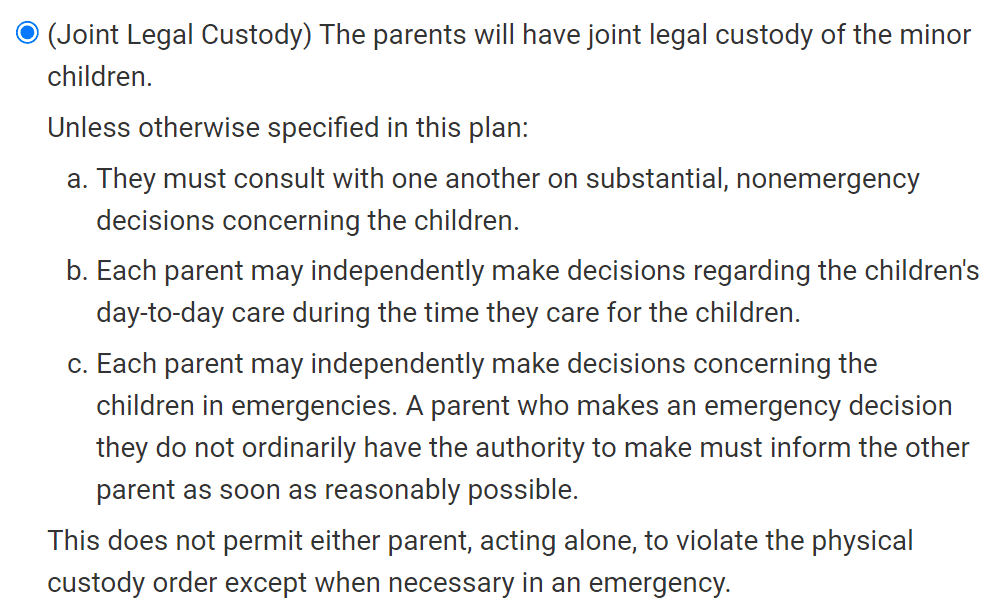Joint Legal Custody Defined
Custody refers to both the legal and physical custody of a child. Legal custody is the authority to make decisions for and about a child.
Joint legal custody (also called shared legal custody, shared parental responsibility, etc.) is when parents share that authority.
The alternative is sole legal custody, where one parent has full responsibility to make major decisions for the child.
You need to specify in your parenting plan which legal custody option your family will use. This determines who makes decisions about your children's education, medical care, religion and more.

You can customize this to fit your situation with Custody X Change.
Basics of joint legal custody
You can have joint legal custody with sole physical custody or joint physical custody, which determine who your child lives with.
Joint legal custody is a way to give both parents a say in their child's upbringing. It is meant for cases in which both parents are able and available to make important decisions.
In many states, it is the default option or is at least preferred over sole legal custody. In these states, sole legal custody is awarded when joint legal custody isn't in the best interest of the child.

You can customize this to fit your situation with Custody X Change.
How joint legal custody is shared
There are many ways parents can share legal custody. Your court may let you decide the specifics, or it may use one of the arrangements below (or a variation) as standard.
Option 1: Parents collaborate on all decisions, whenever feasible. For example, the parents decide together what school their child will attend and whether the child will go on a field trip.
Option 2: Each parent makes decisions for the child when the parent has physical custody. For example, if a teenage daughter asks about birth control while with one parent, that parent can decide whether to take her to a doctor.
Option 3: The parents make big decisions together, and each makes smaller decisions individually when they have physical custody of the child. For example, the parents decide together what school their child attends; if the child has a field trip, the parent who has physical custody during that time decides if they should go.
Option 4: Each parent has authority over certain types of decisions. For example, the mother has the authority to make decisions about school, and the father has authority to make decisions about religion.
Advantages of joint legal custody
When parents work together to make key decisions for their child, the child ultimately benefits.
Continual parent-child communication helps prevent isolation and other psychological issues that could stem from a feeling of loss following a divorce or separation. This helps a child to feel loved by both parents and important to them.
Children who see their parents interact positively, as joint legal custody requires, learn to compromise and work through disagreements. A child is more likely to have a healthy self-esteem if their parents are able to collaborate.
Sharing legal custody can also alleviate the burdens of parenting. Having the other parent's input in difficult decisions can be welcome.
Drawbacks of joint legal custody
If you know that you and the other parent won't be able to share responsibilities regarding your child, joint legal custody is not for you.
For some separated and divorced partners, an acrimonious relationship makes collaborating or even communicating with one another difficult. Family tension can hinder a parent's ability to make decisions in the best interest of their child.
Another thing to consider are the sacrifices joint legal custody can require. For example, you may want to limit your job search to areas near your child to make joint decision-making easier.
When joint legal custody works best
Joint legal custody works well when both parents:
- Agree that a joint legal custody arrangement is in the best interest of the child
- Are willing to cooperate
- Want to be very involved in raising their children
- Share fundamental values
When parents share fundamental values, it's easier for them to make effective decisions regarding their child's school, extracurricular and religious arrangements.
Co-parenting is less likely to be adversarial when parents are on roughly the same page regarding their children.
Designating joint legal custody in your parenting plan
Creating a parenting plan can feel overwhelming.
Use technology to take guesswork out of the equation. The Custody X Change app walks you through each step of creating a comprehensive parenting plan.
Designating joint legal custody in your plan is easy. In the app, click the "parenting plan" tab. More than 25 categories of parenting provisions will appear.

You can customize this to fit your situation with Custody X Change.
Click the second category: legal custody. Then, select the button for "joint legal custody."
Now you're on your way to a professional-quality document for managing joint custody of your child.

You can customize this to fit your situation with Custody X Change.
